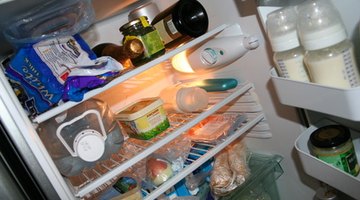Refrigerant Types & Uses
Synthetic and organic refrigerants are classified under two main categories, primary and secondary. Primary refrigerants change states to absorb heat from surrounding areas or substances. Without being pressure-regulated, primary refrigerants absorb all available heat from perishable goods until they're frozen solid.

Secondary refrigerants include air, water or brine as common cooling substances. These substances must be cooled themselves and redistributed through a system to effectively act as refrigerants.
Chlorofluorocarbons (CFC)
CFC compounds are generally of the safest primary refrigerants available. Dichlorodifluoromethane, or R-12 in the industry, is nontoxic, nonflammable, colorless and, when used in low concentrations, odorless. R-12 has a boiling point of -29 degrees Celsius and is generally phased out of use in today's industries. The compound was most commonly found in automobile air conditioners and smaller refrigerators until harmful effects to the ozone layer of Earth's atmosphere were traced to the widespread use of R-12, according to the United Kingdom's Department for Environment Transport Regions.
Hydrochlorofluorocarbons (HCFC)
A once widely used HCFC refrigerant is a synthetic compound called monochlorodifluoromethane, referred to in the industry as R-22. This refrigerant is nontoxic, nonflammable and noncorrosive. It, too, was used mainly in household refrigerators and smaller air conditioning units, until it was implicated in damages rendered to the atmosphere.
Hydrofluorocarbons (HFC)
The most common HFC refrigerant is R-134a, tetrafluoroethane. R-134a has no harmful effects to the earth's atmosphere, is nontoxic and nonflammable. It is used mainly in domestic and auto air conditioning, as well as commercial refrigeration. Due to the minimal harm done to the environment, HFCs recently replaced harmful CFCs and HCFCs in widely used refrigeration systems.
Ammonia
R717 is a commonly used ammonia refrigerant found mainly in industrial cooling systems. The boiling point of R717 is roughly -33 degrees Celsius, enabling temperatures well below zero at atmospheric pressure. Ammonia is a natural, colorless and only moderately flammable refrigerant. Its use has had no damaging effects on the environment, it's lighter than air and is water-soluble. Ammonia is commonly used in meat packing plants, liquid storage and ice skating rinks.
The Drip Cap
- Synthetic and organic refrigerants are classified under two main categories, primary and secondary.
- A once widely used HCFC refrigerant is a synthetic compound called monochlorodifluoromethane, referred to in the industry as R-22.
- R-134a has no harmful effects to the earth's atmosphere, is nontoxic and nonflammable.
- It is used mainly in domestic and auto air conditioning, as well as commercial refrigeration.
- Due to the minimal harm done to the environment, HFCs recently replaced harmful CFCs and HCFCs in widely used refrigeration systems.
Writer Bio
Matt Badger has been writing professionally since 2010, contributing to various websites. Badger has a Bachelor of Science in biology from the University of Washington.
Photo Credits
- contents of fridge image by Christopher Hall from Fotolia.com
- contents of fridge image by Christopher Hall from Fotolia.com
More Articles



